I wrote this on the five day Salkantay trek I did while in Cusco during the last two weeks of my Peru trip. There’s a number of trips you can sign up for in Cusco that include Machu Picchu on the last day, or you can just do Machu Picchu as a day trip. The incredibly ambitious Germans I was traveling with coerced me into this particular trek (the hardest, most badass one), and I am very thankful for that.
***
I am currently covered in dirt and grime–a layer of scum further caked to my skin with sunscreen and bug spray. And surprisingly enough I actually had a shower in the past 24 hours which is much better than my shower record for the past week.
Why am I a walking, blistered, bitten dirt pile? I have just completed the Salkantay Trek. A five day/four night trekking adventure through the high, cold Sierra of southern Peru and then back down through the rainforest ending at Machu Picchu.
I left Horizon school last week in a flourish of abrupt goodbyes and unfinished decisions. I claimed to everyone that I would return for my last weekend in Peru–which is the Peruvian independence holiday. That was a bold statement, and it now seems clear that I definitely will not be accomplishing a plane ride and bus to return to the north before my flight leaves from Lima on the 29th of July. Instead, I will be exploring the beautiful city of Cusco.
Cusco–as our Salkantay guide told us–means navel of the world. I arrived to Cusco last week in the afternoon after a grueling 22 hour bus ride on a winding mountain road. I arrived with some German acquaintances with a plan to get acclimated to the higher altitude for a day and then set off on a trek. Little did I know that these Germans had a more grueling trek in mind than the three day one I assumed I was taking.
Cusco is a small but lively city in the middle of the mountains. For the first time in my almost seven weeks of travel, I felt not at all out of place. Foreigners flock to Cusco because it is the jump off point for seeing Machu Picchu.
The second day, after scheduling our trek, we had to spend preparing. I rented almost everything I needed for heavy trekking and bought more warm clothes which now allows me to be covered from head to toe in alpaca material.
The Salkantay Breakdown
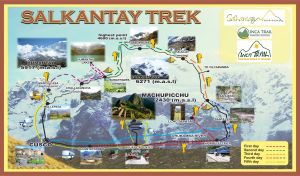
On day one, myself and my compadres left our hostel at 4:30am to follow a guide along darkened Cusco alleys to pick up other Trekkers on the way to the San Francisco Plaza–where we would depart by bus headed to a small town 3 hours northeast.
The trek was hardest on first two days because of the amount of incline walking, and increasing altitude. Everyone warned us about the altitude sickness, and advised different things. Coca products were the most abundant recommendation, and also the easiest to get. Yes–coca… The same coca that when soaked, the liquid product is used to create cocaine. Kind of alarming at first, but we were told that coca products are a trekking must-have. The day before we entered many a coca shop and bought a range of goodies. Coca leaves, coca candy, coca granola bars, coca everything. I was not hesitant to try out my coca because even in Cusco where the altitude is a mere 3,400m, by mid afternoon my head was pounding and I was very fatigued.
The first night we spent on the foothills of the mountains, and we all shivered most of the night in our tents. The second day we had the hardest hike ahead of us to reach the highest point–altitude. The coca leaves quickly became my best friend, especially as we climbed to the “highest point” in the Peruvian sierra amongst the snowcapped mountains the highest of which is Salkantay standing at 6,200m.
What you do is take a small handful of the dried leaves (which smell like herbal tea), and put a small amount of dark black llipta (“yip-tah”) in the middle of the leaves (a taffy like sweet substance from the root of the coca plant), then you roll the leaves up and nestle it in one side of your cheek. With the llipta, the effect is immediate because the alkaloids are more quickly released. The coca leaves cured my headache, and definitely propelled me up the steep inclines when it seemed I had no hope–or maybe it was all a placebo effect… Who knows?
The coca plant–as our guide, Andre, explained–was used for Incan workers and messengers traveling on foot. With coca, you are not thirsty, tired, or muscle fatigued.
I thought about trying to smuggle the rest of my coca goodies into the states, but then quickly decided to give them to a friend going on another mountain trek… Probably a better idea. I could definitely see a scenario of Ellen-not-making-it-back-into-the-states-because-of-the-Peruvian-trekking-vices.
At the highest point we performed an Incan ritual with our guide by placing a rock that we had brought from the bottom of the mountains with a small offering of coca leaves. We gave thanks to each of the mountains in Quechua and drank a bottle of whiskey in a circle. I like Incan rituals.
Our trekking group named itself “Sexy Panaca” meaning “Sexy Family” and we proudly represented the USA, Germany, France, Holland, UK, New Zealand, and China. An interesting bunch that I wouldn’t trade for anything. Nothing brings you closer to people than not bathing for long periods of time, using the bathroom in the wilderness, and chanting in Quechua on a mountain top.
The third day was a breeze of flat rainforest climate that ended with a visit to the crystal clear hot springs of Santa Teresa. Glorious. That evening we stayed in a compound like camping site with other hikers–which also included a quasi bar/snack shop.
Camping in large designated areas along the trek was a blessing and a curse. The camping spots had some sort of bathroom, and long dining tables, but also no privacy and a constant group atmosphere. I enjoyed the trek 100% of the time, but I am also traveling alone and an outgoing person. If a trekker was looking for ultimate serenity and just you and nature, I imagine he or she would be displeased with how the Salkantay is organized.
Following the hot springs day, was zip-lining for an extra fee. Worth it. One should always pay for an opportunity to do a “spider monkey” many feet in the air sailing back and forth in a river valley. This concluded the “roughing it” part of the trip. The last night we got assigned rooms in hostels in Aguas Calientes–the glitz and glam little trinket of a town that is the closet access point to Machu Picchu.
Fifth day, we wake up just shy of 4:00am, and thus begins the dark pilgrimage to get in a line, to walk up a steep incline for 45 minutes, to wait in another line… to enter Machu Picchu park. It does generate a great feeling of triumph–to be one of the first few hundred to enter the park of this ancient mountainside abandoned city just as the sun rises looking back on the past four days of meters and incline hiked.
***
It’s true that everyone asks whether you went to Machu Picchu immediately after you say you spent any time in Peru, and it really is worth it. What I find myself saying is that it truly is a bummer how touristy it is. It’s hard to visualize what the stone city once held when hordes of gumpy foreigners are plowing around snapping photos–me being one of them. Our guide, Andre, also told me that this wonder of the world is crumbling because of all the foot traffic everyday. That’s awful!
I made a great friend on the trails, Ms. Marion. She is as big of a nerd as I am, yet probably much cooler. Check out her directing skills, and our killer dance moves:

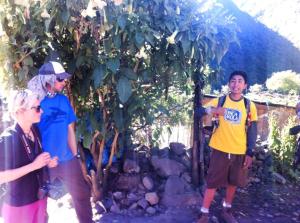

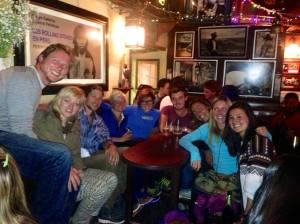
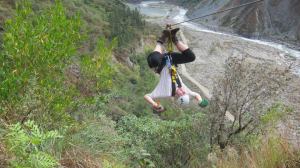
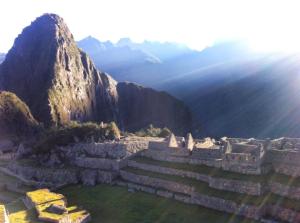
An incredible beautifully told story! Thank you Ellen.
Sent from my iPad